上海交通大学:《台湾研究》课程教学资源(英文PPT课件)08 Civic Exchange across the Taiwan Strait
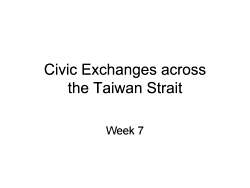
Civic Exchanges across the Taiwan Strait Week 7
Civic Exchanges across the Taiwan Strait Week 7
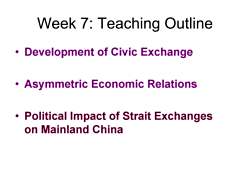
Week 7:Teaching Outline Development of Civic Exchange Asymmetric Economic Relations Political Impact of Strait Exchanges on Mainland China
Week 7: Teaching Outline • Development of Civic Exchange • Asymmetric Economic Relations • Political Impact of Strait Exchanges on Mainland China
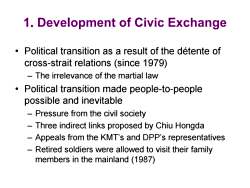
1.Development of Civic Exchange Political transition as a result of the detente of cross-strait relations (since 1979) The irrelevance of the martial law Political transition made people-to-people possible and inevitable Pressure from the civil society Three indirect links proposed by Chiu Hongda Appeals from the KMT's and DPP's representatives Retired soldiers were allowed to visit their family members in the mainland (1987)
1. Development of Civic Exchange • Political transition as a result of the détente of cross-strait relations (since 1979) – The irrelevance of the martial law • Political transition made people-to-people possible and inevitable – Pressure from the civil society – Three indirect links proposed by Chiu Hongda – Appeals from the KMT’s and DPP’s representatives – Retired soldiers were allowed to visit their family members in the mainland (1987)
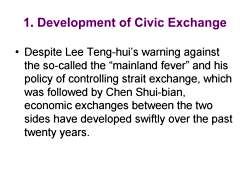
1.Development of Civic Exchange Despite Lee Teng-hui's warning against the so-called the“mainland fever”and his policy of controlling strait exchange,which was followed by Chen Shui-bian, economic exchanges between the two sides have developed swiftly over the past twenty years
1. Development of Civic Exchange • Despite Lee Teng-hui’s warning against the so-called the “mainland fever” and his policy of controlling strait exchange, which was followed by Chen Shui-bian, economic exchanges between the two sides have developed swiftly over the past twenty years
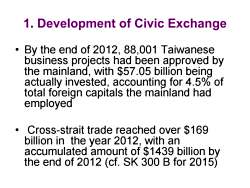
1.Development of Civic Exchange By the end of 2012,88,001 Taiwanese business projects had been approved by the mainland,with $57.05 billion being actually invested,accounting for 4.5%of total foreign capitals the mainland had employed Cross-strait trade reached over $169 billion in the year 2012,with an accumulated amount of $1439 billion by the end of 2012(cf.SK 300 B for 2015)
1. Development of Civic Exchange • By the end of 2012, 88,001 Taiwanese business projects had been approved by the mainland, with $57.05 billion being actually invested, accounting for 4.5% of total foreign capitals the mainland had employed • Cross-strait trade reached over $169 billion in the year 2012, with an accumulated amount of $1439 billion by the end of 2012 (cf. SK 300 B for 2015)

1.Development of Civic Exchange The mainland is No.1 trade partner, biggest export market and No.2 import partner of Taiwan Taiwan is No.7 trade partner,No.9 export market,and No.5 import partner of the mainland
1. Development of Civic Exchange • The mainland is No.1 trade partner, biggest export market and No.2 import partner of Taiwan • Taiwan is No.7 trade partner, No. 9 export market, and No. 5 import partner of the mainland
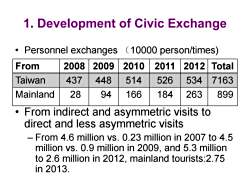
1.Development of Civic Exchange Personnel exchanges (10000 person/times) From 2008 2009 2010 2011 2012 Total Taiwan 437 448 514 526 534 7163 Mainland 28 94 166 184 263 899 From indirect and asymmetric visits to direct and less asymmetric visits -From 4.6 million vs.0.23 million in 2007 to 4.5 million vs.0.9 million in 2009,and 5.3 million to 2.6 million in 2012,mainland tourists:2.75 in2013
1. Development of Civic Exchange • Personnel exchanges (10000 person/times) • From indirect and asymmetric visits to direct and less asymmetric visits – From 4.6 million vs. 0.23 million in 2007 to 4.5 million vs. 0.9 million in 2009, and 5.3 million to 2.6 million in 2012, mainland tourists:2.75 in 2013. From 2008 2009 2010 2011 2012 Total Taiwan 437 448 514 526 534 7163 Mainland 28 94 166 184 263 899
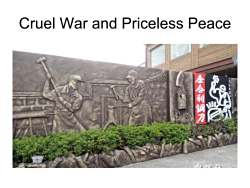
Cruel War and Priceless Peace 全合利铜刀
Cruel War and Priceless Peace
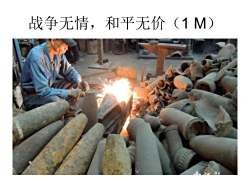
战争无情,和平无价(1M)
战争无情,和平无价(1 M)
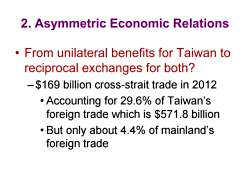
2.Asymmetric Economic Relations From unilateral benefits for Taiwan to reciprocal exchanges for both? -$169 billion cross-strait trade in 2012 Accounting for 29.6%of Taiwan's foreign trade which is $571.8 billion But only about 4.4%of mainland's foreign trade
2. Asymmetric Economic Relations • From unilateral benefits for Taiwan to reciprocal exchanges for both? – $169 billion cross-strait trade in 2012 • Accounting for 29.6% of Taiwan’s foreign trade which is $571.8 billion • But only about 4.4% of mainland’s foreign trade
按次数下载不扣除下载券;
注册用户24小时内重复下载只扣除一次;
顺序:VIP每日次数-->可用次数-->下载券;
- 上海交通大学:《台湾研究》课程教学资源(英文PPT课件)07 Political Interaction across the Taiwan Strait.pptx
- 上海交通大学:《台湾研究》课程教学资源(英文PPT课件)06 Politics of Identity.pptx
- 上海交通大学:《台湾研究》课程教学资源(英文PPT课件)05 Taiwan's Party System short.ppt
- 上海交通大学:《台湾研究》课程教学资源(英文PPT课件)04 Party Politics in Taiwan short.ppt
- 上海交通大学:《台湾研究》课程教学资源(英文PPT课件)03 Conditions and Process of Taiwan's Democratization short.ppt
- 上海交通大学:《台湾研究》课程教学资源(英文PPT课件)02 Historical Roots of the Taiwan Issue short.ppt
- 上海交通大学:《台湾研究》课程教学资源(英文PPT课件)01 Introduction short.ppt
- 上海交通大学:《当代中国外交》课程教学资源_Lesson 9_问题讨论_lesson 9 问题讨论.docx
- 上海交通大学:《当代中国外交》课程教学资源_Lesson 9_中文阅读材料_结构失衡_中苏同盟破裂的深层原因.pdf
- 上海交通大学:《当代中国外交》课程教学资源_Lesson 9_中文阅读材料_张曙光著_经济冷战_美国对华经济禁运和中苏同盟.pdf
- 上海交通大学:《当代中国外交》课程教学资源_Lesson 9_中文阅读材料_中苏关系破裂原因_研究述评.pdf
- 上海交通大学:《当代中国外交》课程教学资源_Lesson 9_中文阅读材料_50年代末至60年代中苏关系恶化的战略_理论与利益背景.pdf
- 上海交通大学:《当代中国外交》课程教学资源_Lesson 8_问题讨论_lesson 8 问题讨论.docx
- 上海交通大学:《当代中国外交》课程教学资源_Lesson 8_中文阅读材料_中苏在援越抗美问题上的冲突与矛盾_1965_1972_下.pdf
- 上海交通大学:《当代中国外交》课程教学资源_Lesson 8_中文阅读材料_中苏在援越抗美问题上的冲突与矛盾_1965_1972_上.pdf
- 上海交通大学:《当代中国外交》课程教学资源_Lesson 8_中文阅读材料_抗美援朝_与_援越抗美_中国如何应对朝鲜战争和越南战争_章百家.pdf
- 上海交通大学:《当代中国外交》课程教学资源_Lesson 7_问题讨论_lesson 7 问题讨论.docx
- 上海交通大学:《当代中国外交》课程教学资源_Lesson 7_中文阅读材料_难以弥合的裂痕_苏联对中印冲突的立场及中苏分歧公开化_1959_1960.pdf
- 上海交通大学:《当代中国外交》课程教学资源_Lesson 7_中文阅读材料_关于1962年中印边界冲突和中苏分裂研究的若干问题.pdf
- 上海交通大学:《当代中国外交》课程教学资源_Lesson 7_中文阅读材料_中印边界冲突与苏联的反应和政策.pdf
- 上海交通大学:《台湾研究》课程教学资源(英文PPT课件)09-10 U.S.-Taiwan Relations.ppt
- 上海交通大学:《台湾研究》课程教学资源(英文PPT课件)11 Prospects of Cross-Strait Relations short.ppt
- 上海交通大学:《台湾研究》课程教学资源_China's National Identity under Reconstruction.docx
- 上海交通大学:《台湾研究》课程教学资源_Party Politics.docx
- 上海交通大学:《台湾研究》课程教学资源_再论台湾两党体系的可延续.pdf
- 上海交通大学:《台湾研究》课程教学资源(中文PPT课件)03 台湾政治转型的启动.ppt
- 上海交通大学:《台湾研究》课程教学资源(中文PPT课件)04 台湾政治转型的嬗变.ppt
- 上海交通大学:《台湾研究》课程教学资源(中文PPT课件)05 台湾政治转型与涉外关系.ppt
- 上海交通大学:《台湾研究》课程教学资源(中文PPT课件)06 政治转型与美台关系.ppt
- 上海交通大学:《台湾研究》课程教学资源(中文PPT课件)07 台湾政治转型与大陆政策.ppt
- 上海交通大学:《台湾研究》课程教学资源(中文PPT课件)08 台湾政治转型与大陆对台政策.ppt
- 上海交通大学:《台湾研究》课程教学资源(中文PPT课件)09 台湾政治转型与两岸关系.ppt
- 上海交通大学:《台湾研究》课程教学资源(中文PPT课件)10 两岸关系和平发展的前景.ppt
- 上海交通大学:《台湾研究》课程教学资源_阅读材料_2012年台湾选举对政党体系的影响.pdf
- 上海交通大学:《台湾研究》课程教学资源_阅读材料_两岸关系和平发展的机遇和路径.pdf
- 上海交通大学:《台湾研究》课程教学资源_阅读材料_台海问题中的美国因素.pdf
- 上海交通大学:《台湾研究》课程教学资源_阅读材料_台湾当局_活路外交_评析.pdf
- 上海交通大学:《台湾研究》课程教学资源_阅读材料_台湾政党体系发展趋势探析.pdf
- 上海交通大学:《台湾研究》课程教学资源_阅读材料_台湾问题_美国对华政策中的两难议题.pdf
- 上海交通大学:《台湾研究》课程教学资源_阅读材料_奥巴马政府的两岸关系政策.pdf
